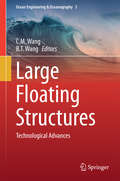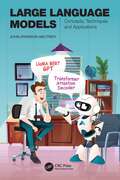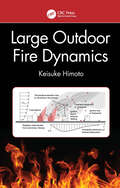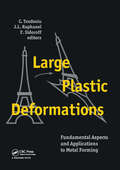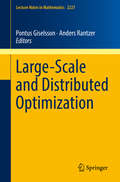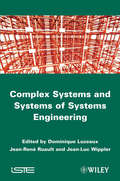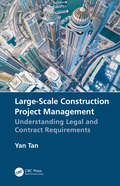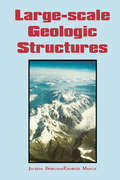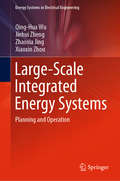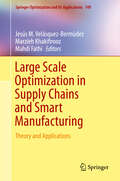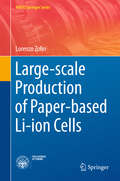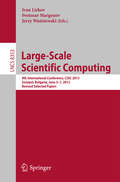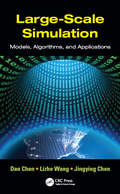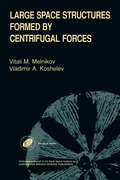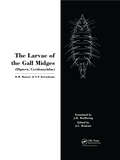- Table View
- List View
Large Floating Structures
by C. M. Wang B. T. WangThis book surveys key projects that have seen the construction of large floating structures or have attained detailed conceptual designs. This compilation of key floating structures in a single volume captures the innovative features that mark the technological advances made in this field of engineering and will provide a useful reference for ideas, analysis, design and construction of these unique and emerging urban projects to offshore and marine engineers, urban planners, architects and students.
Large Language Models: Concepts, Techniques and Applications
by John Atkinson-AbutridyThis book serves as an introduction to the science and applications of Large Language Models (LLMs). You'll discover the common thread that drives some of the most revolutionary recent applications of artificial intelligence (AI): from conversational systems like ChatGPT or BARD, to machine translation, summary generation, question answering, and much more.At the heart of these innovative applications is a powerful and rapidly evolving discipline, natural language processing (NLP). For more than 60 years, research in this science has been focused on enabling machines to efficiently understand and generate human language. The secrets behind these technological advances lie in LLMs, whose power lies in their ability to capture complex patterns and learn contextual representations of language. How do these LLMs work? What are the available models and how are they evaluated? This book will help you answer these and many other questions. With a technical but accessible introduction: You will explore the fascinating world of LLMs, from its foundations to its most powerful applications You will learn how to build your own simple applications with some of the LLMs Designed to guide you step by step, with six chapters combining theory and practice, along with exercises in Python on the Colab platform, you will master the secrets of LLMs and their application in NLP.From deep neural networks and attention mechanisms, to the most relevant LLMs such as BERT, GPT-4, LLaMA, Palm-2 and Falcon, this book guides you through the most important achievements in NLP. Not only will you learn the benchmarks used to evaluate the capabilities of these models, but you will also gain the skill to create your own NLP applications. It will be of great value to professionals, researchers and students within AI, data science and beyond.
Large MIMO Systems
by A. ChockalingamLarge MIMO systems, with tens to hundreds of antennas, are a promising emerging communication technology. This book provides a unique overview of this technology, covering the opportunities, engineering challenges, solutions, and state-of-the-art of large MIMO test beds. There is in-depth coverage of algorithms for large MIMO signal processing, based on meta-heuristics, belief propagation and Monte Carlo sampling techniques, and suited for large MIMO signal detection, precoding, and LDPC code designs. The book also covers the training requirement and channel estimation approaches in large-scale point-to-point and multi-user MIMO systems; spatial modulation is also included. Issues like pilot contamination and base station cooperation in multi-cell operation are addressed. A detailed exposition of MIMO channel models, large MIMO channel sounding measurements in the past and present, and large MIMO test beds is also presented. An ideal resource for academic researchers, next generation wireless system designers and developers, and practitioners in wireless communications.
Large Outdoor Fire Dynamics
by Keisuke HimotoLarge Outdoor Fire Dynamics provides the essential knowledge for the hazard evaluation of large outdoor fires, including wildland, WUI (wildland-urban interface), and urban fires. The spread of outdoor fires can be viewed as a successive occurrence of physical and chemical processes – solid fuel combustion, heat transfer to surrounding combustibles, and ignition of heated combustibles – which are explained herein. Engineering equations frequently used in practical hazard analyses are derived and then integrated to implement a computational code predicting fire spread among discretely distributed combustibles. This code facilitates learning the procedure of hazard evaluation for large outdoor fires. Chapters cover underlying assumptions for analyzing fire spread behavior in large outdoor fires, namely, wind conditions near the ground surface and fundamentals of heat transfer; the physical mechanism of fire spread in and between combustibles, specifically focusing on fire plumes (both reacting and non-reacting) and firebrand dispersal; and the spatial modeling of 3D objects and developing the computational framework for predicting fire spread. The book is ideal for engineers, researchers, and graduate students in fire safety as well as mechanical engineering, civil engineering, disaster management, safety engineering, and planning. Companion source codes are available online.
Large Plastic Deformations: Proceedings of the international seminar MECAMAT'91, Fontainebleau, France, 7-9 August 1991
by C.TEODOSIU; J.L.RAPHANEL; F.SIDOROFFThis volume covers topics involving large plastic deformation of metallic materials. These proceedings offer an overview of the synergism achieved by combining microstructural characterization and understanding, mechanical modelling and experiments, numerical analysis and computation.
Large-scale 3D Data Integration: Challenges and Opportunities
by Sisi Zlatanova David ProsperiLarge-Scale 3D Data Integration: Challenges and Opportunities examines the fundamental aspects of 3D geo-information, focusing on the latest developments in 3D GIS (geographic information) and AEC (architecture, engineering, construction) systems. This book addresses policy makers, designers and engineers, and individuals that need to overco
Large-Scale and Distributed Optimization (Lecture Notes in Mathematics #2227)
by Pontus Giselsson Anders RantzerThis book presents tools and methods for large-scale and distributed optimization. Since many methods in "Big Data" fields rely on solving large-scale optimization problems, often in distributed fashion, this topic has over the last decade emerged to become very important. As well as specific coverage of this active research field, the book serves as a powerful source of information for practitioners as well as theoreticians.Large-Scale and Distributed Optimization is a unique combination of contributions from leading experts in the field, who were speakers at the LCCC Focus Period on Large-Scale and Distributed Optimization, held in Lund, 14th–16th June 2017. A source of information and innovative ideas for current and future research, this book will appeal to researchers, academics, and students who are interested in large-scale optimization.
Large-scale Complex System and Systems of Systems
by Dominique Luzeaux Jean-René Ruault Jean-Luc WipplerWith the growing maturity of information and communication technologies, systems have been interconnected within growing networks, yielding new services through a combination of the system functionalities. This leads to an increasing complexity that has to be managed in order to take advantage of these system integrations. This book provides key answers as to how such systems of systems can be engineered and how their complexity can be mastered. After reviewing some definitions on systems of systems engineering, the book focuses on concrete applications and offers a survey of the activities and techniques that allow engineering of complex systems and systems of systems. Case studies, ranging from emergency situations such as Hurricane Katrina and its crisis management or a generic scenario of a major traffic accident and its emergency response, to the establishment of a scientific basis in the Antarctic region illustrate key factors of success and traps to avoid in order to cope with such situations.
Large-Scale Construction Project Management: Understanding Legal and Contract Requirements
by Yan TanA majority of large-scale construction and major infrastructure projects are funded by public funds from taxpayers. However, these projects are often subject to severe delays and cost overruns. Large-Scale Construction Project Management: Understanding Legal and Contract Requirements introduces integrated approaches to project management and control mechanisms to effectively manage large-scale construction projects. It explains the contractual requirements and associated legal principles under the latest edition of the leading standard forms of contracts, including FIDIC 2017, NEC4, and JCT 2016. It explains integrated project governance regarding time, cost, risk, change, contract management, and more. Further, it discusses the legal issues of scheduling delays and disruptions regarding the Delay and Disruption Protocol (Society of Construction Law) as well as Forensic Schedule Analysis guidance (American Association of Cost Engineering). Features: Provides strategies to effectively resolve disputes during construction projects Examines Quantitative Schedule Risk Analysis (QSRA) and Quantitative Cost Risk Analysis (QCRA) Introduces the most recent software and techniques used in managing large-scale construction projects This book serves as a useful resource for project control and management professionals, researchers in construction management and project management, and students in building construction management and project management.
Large-Scale Geologic Structures
by Jacques Debelmas Georges MascleThis text is a translation of "Les Grandes Structures Geologiques", Paris 1997. It is devoted to the study of major geological features such as oceanic ridges, continental margins, sedimentary basins and mountain chains.
Large-Scale Grid-Connected Wind and Photovoltaic Farms: Modeling, Stability and Control (Smart Energy Systems)
by Hongyu Zhou Wei Yao Yongxin Xiong Jinyu WenThis book provides a comprehensive study of the modeling, analysis, and control of wind farms and solar power stations. It starts with dynamic vector modeling methods for wind farms and solar power stations, which enhance modeling efficiency and model accuracy. Building upon this modeling framework, it also covers stability analysis and control methods for wind farms and solar power stations from both steady-state and transient perspectives. Lastly, considering the integration of energy storage into renewable energy power stations, the book explores the analysis and control of wind-energy storage and solar-energy storage hybrid systems. It adopts a holistic approach, establishing a fundamental framework for the topic, progressing from modeling to analysis and then to control, facilitating readers' comprehension. The book is targeted towards undergraduate and graduate students interested in renewable energy power stations, researchers focusing on station-level modeling, analysis, and control of renewable energy, as well as engineers in the field.
Large-Scale Integrated Energy Systems: Planning and Operation (Energy Systems in Electrical Engineering)
by Qing-Hua Wu Jiehui Zheng Zhaoxia Jing Xiaoxin ZhouThis book discusses key issues in the planning and operation of large-scale integrated energy systems (LSIES). It establishes individual-based models for LSIES and develops multi-objective optimization algorithms and multi-attribute decision making support systems, which are applied to the planning and optimal operation of LSIES. It is a valuable reference work for researchers, students and engineers who are interested in energy systems, operation research and decision theory.
Large Scale Networks: Modeling and Simulation
by Radu Dobrescu Florin IonescuThis book offers a rigorous analysis of the achievements in the field of traffic control in large networks, oriented on two main aspects: the self-similarity in traffic behaviour and the scale-free characteristic of a complex network. Additionally, the authors propose a new insight in understanding the inner nature of things, and the cause-and-effect based on the identification of relationships and behaviours within a model, which is based on the study of the influence of the topological characteristics of a network upon the traffic behaviour. The effects of this influence are then discussed in order to find new solutions for traffic monitoring and diagnosis and also for traffic anomalies prediction. Although these concepts are illustrated using highly accurate, highly aggregated packet traces collected on backbone Internet links, the results of the analysis can be applied for any complex network whose traffic processes exhibit asymptotic self-similarity, perceived as an adaptability of traffic in networks. However, the problem with self-similar models is that they are computationally complex. Their fitting procedure is very time-consuming, while their parameters cannot be estimated based on the on-line measurements. In this aim, the main objective of this book is to discuss the problem of traffic prediction in the presence of self-similarity and particularly to offer a possibility to forecast future traffic variations and to predict network performance as precisely as possible, based on the measured traffic history.
Large Scale Optimization in Supply Chains and Smart Manufacturing: Theory and Applications (Springer Optimization and Its Applications #149)
by Jesús M. Velásquez-Bermúdez Marzieh Khakifirooz Mahdi FathiIn this book, theory of large scale optimization is introduced with case studies of real-world problems and applications of structured mathematical modeling. The large scale optimization methods are represented by various theories such as Benders’ decomposition, logic-based Benders’ decomposition, Lagrangian relaxation, Dantzig –Wolfe decomposition, multi-tree decomposition, Van Roy’ cross decomposition and parallel decomposition for mathematical programs such as mixed integer nonlinear programming and stochastic programming. Case studies of large scale optimization in supply chain management, smart manufacturing, and Industry 4.0 are investigated with efficient implementation for real-time solutions. The features of case studies cover a wide range of fields including the Internet of things, advanced transportation systems, energy management, supply chain networks, service systems, operations management, risk management, and financial and sales management. Instructors, graduate students, researchers, and practitioners, would benefit from this book finding the applicability of large scale optimization in asynchronous parallel optimization, real-time distributed network, and optimizing the knowledge-based expert system for convex and non-convex problems.
Large-scale Production of Paper-based Li-ion Cells
by Lorenzo ZolinThis book describes in detail the use of natural cellulose fibers for the production of innovative, low-cost, and easily recyclable lithium-ion (Li-ion) cells by means of fast and reliable papermaking procedures that employ water as a solvent. In addition, it proposes specific methods to optimize the safety features of these paper-based cells and to improve the electronic conductivity of the electrodes by means of a carbonization process- an interesting novel technology that enables higher current rate capabilities to be achieved. The in-depth descriptions of materials, methods, and techniques are complemented by the inclusion of a general overview of electrochemical devices and, in particular, of different Li-ion battery configurations. Presenting the outcomes of this important research, the work is of wide interest to electrochemical engineers in both research institutions and industry.
Large Scale Renewable Power Generation
by Jahangir Hossain Apel MahmudThis book focuses on the issues of integrating large-scale renewable power generation into existing grids. The issues covered in this book include different types of renewable power generation along with their transmission and distribution, storage and protection. It also contains the development of medium voltage converters for step-up-transformer-less direct grid integration of renewable generation units, grid codes and resiliency analysis for large-scale renewable power generation, active power and frequency control and HVDC transmission. The emerging SMES technology for controlling and integrating large-scale renewable power systems is also discussed. Since the protection issues with large-scale distributed renewable power systems are different compared to the existing protection system for one way power flow, this book includes a new protection technique for renewable generators along with the inclusion of current status of smart grid. This book is a good reference for the researchers who are working the area of renewable power generation and smart grids.
Large-Scale Scientific Computing
by Ivan Lirkov Svetozar MargenovThepapersinthis volumewerepresentedatthe4thInternationalConferenceon Large-Scale Scienti'c Computations ICLSSC 2003. It was held in Sozopol, B- garia, June 4-8, 2003. The conference was organized and sponsored by the C- tral Laboratory for Parallel Processing at the Bulgarian Academy of Sciences. Support was also provided from the Center of Excellence "BIS 21" (funded by the European Commission), SIAM and GAMM. A co-organizer of this tra- tional scienti'c meeting was the Division of Numerical Analysis and Statistics of the University of Rousse. The success of the conference and the present volume in particular are the outcome of the joint e'orts of many colleagues from various institutions and organizations. First thanks to all the members of the Scienti'c Committee for their valuable contribution to forming the scienti'c face of the conference, as well as for their help in reviewing contributed papers. We would like to specially thank the organizers of the special sessions: R. Blaheta, N. Dimitrova, A. Ebel, K. Georgiev, O. Iliev, A. Karaivanova, H. Kosina, M. Krastanov, U. Langer, P. Minev, M. Neytcheva, M. Sch] afer, V. Veliov, and Z. Zlatev. We are also grateful to the sta? involved in the local organization. Special Events: - The conference was devoted to the 60th anniversary of Raytcho Lazarov. - During the conference, the nomination for the World Level of the Hall of Fame for Engineering, Science and Technology, HOFEST, was o'cially awarded to Owe Axelsson.
Large-Scale Scientific Computing
by Ivan Lirkov Svetozar Margenov Jerzy WaśniewskiThis book constitutes the thoroughly refereed post-conference proceedings of the 9th International Conference on Large-Scale Scientific Computations, LSSC 2013, held in Sozopol, Bulgaria, in June 2013. The 74 revised full papers presented together with 5 plenary and invited papers were carefully reviewed and selected from numerous submissions. The papers are organized in topical sections on numerical modeling of fluids and structures; control and uncertain systems; Monte Carlo methods: theory, applications and distributed computing; theoretical and algorithmic advances in transport problems; applications of metaheuristics to large-scale problems; modeling and numerical simulation of processes in highly heterogeneous media; large-scale models: numerical methods, parallel computations and applications; numerical solvers on many-core systems; cloud and grid computing for resource-intensive scientific applications.
Large-Scale Simulation: Models, Algorithms, and Applications
by Lizhe Wang Dan Chen Jingying ChenLarge-Scale Simulation: Models, Algorithms, and Applications gives you firsthand insight on the latest advances in large-scale simulation techniques. Most of the research results are drawn from the authors’ papers in top-tier, peer-reviewed, scientific conference proceedings and journals. The first part of the book presents the fundamentals of large-scale simulation, including high-level architecture and runtime infrastructure. The second part covers middleware and software architecture for large-scale simulations, such as decoupled federate architecture, fault tolerant mechanisms, grid-enabled simulation, and federation communities. In the third part, the authors explore mechanisms—such as simulation cloning methods and algorithms—that support quick evaluation of alternative scenarios. The final part describes how distributed computing technologies and many-core architecture are used to study social phenomena. Reflecting the latest research in the field, this book guides you in using and further researching advanced models and algorithms for large-scale distributed simulation. These simulation tools will help you gain insight into large-scale systems across many disciplines.
Large-Scale Solar Power Systems
by Peter GevorkianThis book is a comprehensive discussion and economic analysis of large-scale solar power systems, specifically referencing critical issues related to design construction and financing. The book provides practical design, installation, and financing guidelines for large-scale commercial and industrial solar power projects. Engineering design and construction methodologies as well as economic analysis provide a step by step walk-through of all aspects of solar power systems. Design methodologies outline the specific requirements of solar and electrical design and construction documentation in meticulous detail, which can readily be applied to ground mount, roof mount, building integrated (BIPV), and carport-type solar power projects. In view of the importance of solar power systems as a viable present and future energy resource, the book includes a dedicated chapter on smart grid transmission and large-scale energy storage systems.
Large Space Structures Formed by Centrifugal Forces
by V A Koshelev V M MelnikovThis book describes a feasible means of constructing such a reflector, as well as simple, reliable and low-cost structures for television and radio transmissions, debris removal from space and the development of solar sails for interplanetary missions. The aim of this book is thus to provide a comprehensive overview of the research in the technology of such space based structures expanded by centrifugal forces. The most promising concepts and design solutions for different applications are addressed. Particular emphasis is placed on deployment dynamics of space-based structures and their retrieval techniques: the reorientation of expanded film sheets in space, selecting film folding patterns, tethering systems, and deployment mechanisms, and controlling the deployment-retrieval process by space vehicles. Also featured are sections on ground and orbital simulation.
Large Turbo-Generators: Malfunctions and Symptoms (Ieee Press Series On Power Engineering Ser. #38)
by Isidor Kerszenbaum Geoff KlempnerThis book presents a comprehensive, ordered relationship between malfunctions and symptoms occurring in large turbogenerators. With this book, the operator and/or engineer in a generating station could identify underlying causes of a developing component degradation or a failure quicker, which could potentially save both time and money and reduce the trial-and-error troubleshooting process. Large turbogenerators are the most important source of electricity. They can be found in thousands of power stations in every country. Forced outages, failures and degradation of these very expensive machines have an enormous aggregate cost to society. As such, any tool that can ameliorate loss of production by shaving time from troubleshooting activities, and avoiding unnecessary costs by detecting and promptly responding to component degradation, represents a step forward.
Largemouth Bass Aquaculture
by James Tidwell Shawn Coyle Leigh Anne BrightLargemouth bass (Micropterus salmoides) are highly prized as sports fish and increasingly as high-value food fish. The farming of largemouth bass is becoming increasingly important and international as the procedures and management for successful culture are being refined. Largemouth bass aquaculture is now widespread across the USA and increasingly in other countries worldwide; the largemouth bass aquaculture industry in China is particularly strong. Largemouth Bass Aquaculture provides comprehensive coverage of all aspects of the farming of largemouth bass, with chapters encompassing all major areas of importance, including their history, production, environment requirements, reproduction, culture methods, diseases and major markets. Many of the world's experts in the field have contributed chapters to this landmark publication and the editors are very well known and respected worldwide. The book is fully international in scope, drawing information from many countries where largemouth bass are farmed. Largemouth Bass Aquaculture is an important resource for those working in aquaculture, including fish farm operatives and managers, veterinarians and fish health managers, inspectors and consultants. Personnel within companies supplying the aquaculture industry with feed, technical equipment and pharmaceuticals will find a wealth of useful information within this book. Libraries in all universities and establishments teaching and researching aquaculture, fish biology, ichthyology, fisheries, aquatic sciences and veterinary studies should have copies of this comprehensive book on their shelves.
The Larvae of the Gall Miges
by B.M. Mamaev N.P. KrivosheinaThe characteristics of all main groups of soil-bound insects are given in this book.
Larval Fish Nutrition
by G. Joan HoltNutrition is particularly important in the healthy development of fish during their early-life stages. Understanding the unique nutritional needs of larval fish can improve the efficiency and quality of fish reared in a culture setting. Larval Fish Nutrition comprehensively explores the nutritional requirements, developmental physiology, and feeding and weaning strategies that will allow aquaculture researchers and professionals to develop and implement improved culture practices. Larval Fish Nutrition is logically divided into three sections. The first section looks at the role of specific nutrient requirements in the healthy digestive development of fish. The second section looks at the impacts if nutritional physiology on fish through several early-life stages. The final section looks at feeding behaviors and the benefits and drawbacks to both live feed and microparticulate diets in developing fish. Written by a team of leading global researchers, Larval Fish Nutrition will be an indispensible resource for aquaculture researchers, professionals, and advanced students. Key Features: Reviews the latest research on larval fish nutritional requirements, developmental physiology, and feeding and weaning strategies Extensively covers nutritional needs of various early-life stages in fish development Weighs the benefits and drawbacks to both live feeds and microparticulate diets Written by a global team of experts in fish nutrition and physiology
